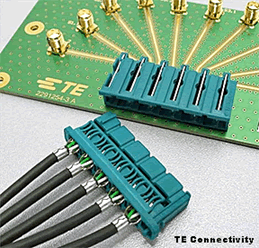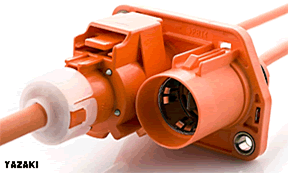Automotive Connectors Roar
Connectors associated with automotive applications have recently been a bright spot in the overall connector market, but are likely at the early stage of an incredible growth curve.
 Bishop & Associates recently reported the global connector market grew 4.1% in 2016 over 2015, while the automotive connector segment expanded by 8.1%, totaling nearly $13 billion in sales. There are a host of good reasons to expect these numbers to increase by high single digits over the next few years.
Bishop & Associates recently reported the global connector market grew 4.1% in 2016 over 2015, while the automotive connector segment expanded by 8.1%, totaling nearly $13 billion in sales. There are a host of good reasons to expect these numbers to increase by high single digits over the next few years.
Not long ago, automotive connectors were often designed around several basic requirements, including, in no certain order:
- 12VDC power delivery for control and lighting circuits
- Environmentally sealed for under-hood applications
- Unsealed in passenger compartment applications
- Ability to withstand shock and vibration over long periods
- Ability to survive harsh automotive assembly processes
- Positive latching, anti-contact back-out features
- Low cost
FAKRA coaxial connectors rated to 3GHz and commonly used in antenna applications were about as high-tech as it got.
The typical car today has become a series of computers on wheels that relies on a vast array of sensors linked by a high-speed network to deliver significantly improved levels of performance, safety, convenience, navigation, communication, and entertainment. The mechanical, environmental, and economic requirements of interconnects remain challenging, but additional performance demands now include:
- Much higher circuit counts, voltage, and current
- Ability to conduct high-speed, low-level digital and analog signals in a noisy EMI environment
- Compatibility with unshielded twisted pair and shielded differential pair cabling
- Smaller interfaces with reduced weight
- Simplified assembly
- Press-fit termination to PCBs
- Increased reliability
Cars on the market today incorporate electronic control of the engine, transmission, emissions, and speed, as well as cabin comfort and entertainment systems. Forward-looking radar provides input for emergency braking systems, while cameras generate video streams for lane change detection and object detection when reversing. Heads-up instrument displays are starting to appear in even mid-range vehicle models, and some cars now far exceed their owner’s ability to parallel park. Additionally, infotainment features now offer Bluetooth and Wi-Fi connectivity along with interactive voice recognition.
 All of these capabilities require high-speed networks that are slowly evolving from CAN bus to Ethernet, so connector companies are already tooling connectors designed to support automotive Ethernet. TE Connectivity recently introduced their new MATEnet modular connector, and Delphi has tooled their Automotive Modular Ethernet Connection (AMEC) system, which is rated to 1Gb/s.
All of these capabilities require high-speed networks that are slowly evolving from CAN bus to Ethernet, so connector companies are already tooling connectors designed to support automotive Ethernet. TE Connectivity recently introduced their new MATEnet modular connector, and Delphi has tooled their Automotive Modular Ethernet Connection (AMEC) system, which is rated to 1Gb/s.
Legacy 12-volt DC power distribution systems are moving toward a dual 12/48-volt standard that offers efficiency advantages, but will require a new generation of sealed power distribution connectors. Hybrid and all-electric cars must manage much higher voltages, up to 750V and 300A, necessitating interconnects that have higher insulation qualities, as well as no-touch safety features on a wide range of cable sizes.
 Yazaki has developed a series of high-voltage connectors specifically targeting the requirements of hybrid vehicles.
Yazaki has developed a series of high-voltage connectors specifically targeting the requirements of hybrid vehicles.
As advanced and complex as today’s cars have become, the industry has only yet begun to address the interconnects required to continue moving toward fully autonomous transportation systems. The Society of Automotive Engineers (SAE) has defined five levels of automotive automation. Vehicles currently on the market are likely operating somewhere between levels two and three. Level three increases the number of automated functions, but keeps the human driver in ultimate control of the vehicle, while level four allows automated control under defined conditions, and level five achieves full-time automation without human involvement.
Interconnects utilized in level four and five vehicles will require signal integrity at an unprecedented level. Input from hundreds of sensors, including radar and lidar proximity sensors, must be delivered to high-speed processors responsible for making steering and braking decisions in real time to ensure safety, as any delay, corruption, or failure of these critical signals could have life or death consequences. The systems and software that will provide the level of safety required will all but certainly involve extensive redundancies, and the cables and connectors used to deliver these signals will have performance criteria similar to aircraft interfaces, but produced at consumer product volumes and prices.
The future of personal transportation will not stop with impacts on the vehicle either. Autonomous cars will not only detect and talk to each other, but will eventually communicate with traffic control systems as well. Much of today’s traffic control is based on timers and embedded road sensors. Upgraded traffic management systems will be capable of sensing the volume of vehicles and use artificial intelligence to manage the most efficient movement of traffic. However, achieving this level of smart traffic control will require a major upgrade of the millions of traffic control signals currently installed. The Midtown in Motion project currently employed in downtown Manhattan utilizes a network of sensors and video cameras to identify congestion, and allows traffic engineers to manually adjust traffic control devices to improve the flow of traffic. The next step will be direct communication between cars and automated management computers, and will require even greater numbers of sensors, microcontrollers, and higher-performance, ruggedized, high-speed connectors and cable assemblies.
Traditional automotive manufacturers, as well as industry disruptors such as Google and Uber, are actively road-testing prototype vehicles with the objective of collecting the wealth of real-world data necessary to offer safe and reliable fully autonomous vehicles beginning in 2020 or 2021. Level five vehicles may not be viable for those living in rural locations, but make perfect sense in high-density urban areas where transportation as a service may become the norm.
Recognizing the incredible opportunities created by next-generation transportation systems, the connector industry is gearing up to take on these challenges. Suppliers such as Amphenol, AVX, Delphi, Hirose, Lumberg, Molex, Rosenberger, JAE, JST, Sumitomo, TE Connectivity, and Yazaki are actively developing the interfaces and components that will be critical to realizing a growing fleet of hybrid, electric, and fully autonomous vehicles.
Advanced automotive electronics, sensors, software, and associated interconnects are now in the process of enabling a wave of disruptive innovation in human transportation.
Bishop & Associates recently published a detailed market research report that identifies autonomous electric transportation as one of ten disruptive innovative technologies likely to have a major impact on the electronic connector industry. Click here for more information on report M-760-16: The Impact of Disruptive Innovations on Electronic Interconnects.
Recently posted:
[related_posts limit=”10″]
- Optics Outpace Copper at OFC 2024 - April 16, 2024
- Digital Lighting Enhances your Theatrical Experience - March 5, 2024
- DesignCon 2024 in Review - February 13, 2024






